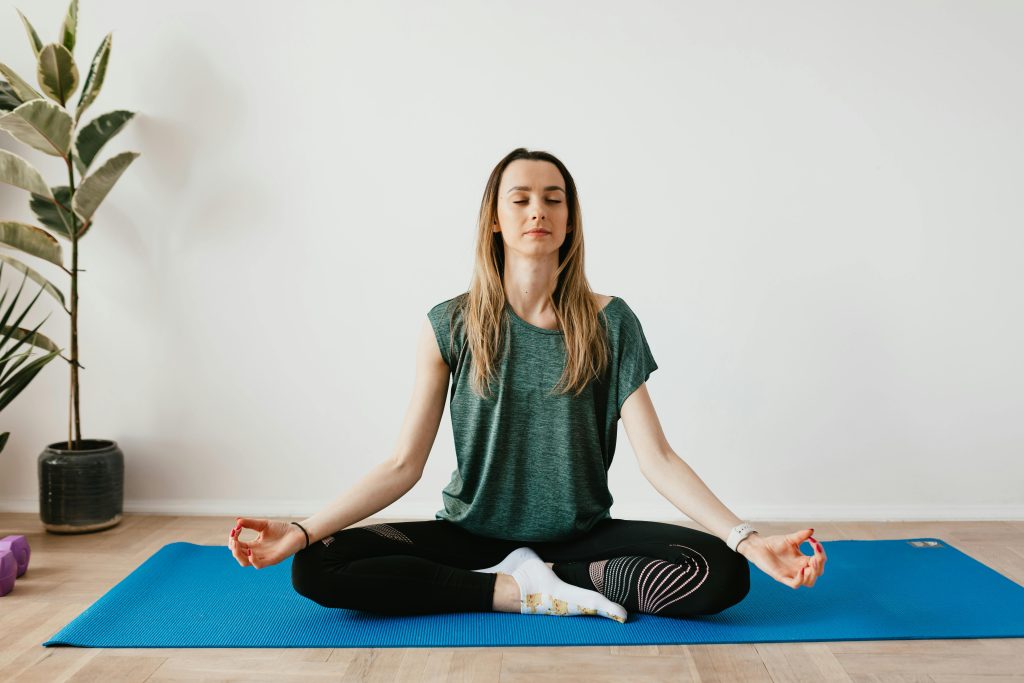Introduction
Have you ever wondered why meditation and mindfulness are often mentioned together yet feel so distinct? While these practices share many benefits—like reduced stress and improved focus—they serve different purposes and follow different methods. This blog post dives into the nuances of both mindfulness and meditation. You’ll learn clear definitions, explore how each practice works, and discover practical tips to incorporate them into your daily life. By the end, you’ll understand not only how meditation and mindfulness overlap but also why choosing one (or both) can transform your mental well-being.

What Is Meditation?
Formal Practice and Its Varieties
Meditation refers to structured techniques designed to train the mind. Most meditation sessions involve setting aside a dedicated block of time—often 5, 10, or 20 minutes—and concentrating on a specific focal point. Common meditation styles include:
- Concentrative Meditation:
- Focus on a single object, such as the breath, a mantra (“Om”), or a flickering flame.
- Whenever your mind wanders, label the distraction (“thinking,” “planning,” or “feeling”) and gently return to your chosen anchor.
- Open-Monitoring (Insight) Meditation:
- Instead of zeroing in on one point, you remain receptive to any thought, sensation, or sound.
- Observe everything that arises—physical sensations, emotions, mental chatter—without judgment.
- Loving-Kindness (Metta) Meditation:
- Cultivate compassion by silently repeating phrases like “May I be safe. May I be happy.”
- Gradually extend these wishes to loved ones, acquaintances, and even people you find challenging.
- Guided Visualization or Mantra Meditation:
- Follow an audio guide through a scenic mental journey (e.g., a beach at sunset) or repeat a mantra in your mind.
- Notice when visualization breaks down or your mind drifts—then calmly redirect your attention.
Goals of Formal Meditation
- Calm and Relaxation:
Many beginners start meditation to reduce anxiety and elicit the “relaxation response,” a physiological state marked by slower breathing, lowered heart rate, and reduced stress hormones (cortisol). - Enhanced Concentration:
Focusing on a singular point in the present moment—and repeatedly returning your attention there—strengthens neural pathways associated with attention and reduces distractibility over time. - Insight and Self-Inquiry:
In traditions like Vipassanā (Insight) or Zen, meditators look deeply into the nature of thought and experience, aiming to develop clarity about how the mind generates suffering and how to transcend it. - Cultivation of Specific States:
Practices such as loving-kindness meditation explicitly aim to foster positive emotions—compassion, gratitude, empathy—by training your mind to dwell on kind intentions.
What Is Mindfulness?
A Quality of Awareness
Unlike meditation, which is typically a set-apart activity, mindfulness is an attitude or quality of present-moment awareness. At its core, mindfulness means:

- Paying Attention on Purpose:
Consciously noticing thoughts, sensations, or surroundings rather than operating on autopilot. - Remaining in the Present:
Instead of ruminating about the past or worrying about the future, you bring gentle focus to what is happening right now. - Nonjudgmental Observation:
You observe experiences—pleasant or unpleasant—without labeling them as “good” or “bad.” This acceptance reduces reactive patterns and fosters equanimity.
Formal vs. Informal Mindfulness
- Formal Mindfulness Practice:
Often overlaps with meditation. For example, a 20-minute “body scan” where you methodically move attention through different body parts, noticing each sensation without judgment. - Informal Mindfulness Practice:
Embedded into daily activities—brushing teeth, driving, washing dishes—where you bring deliberate attention to the task at hand. For instance:- While eating lunch, you notice the texture, taste, and aroma of each bite, fully experiencing the meal.
- During a work meeting, you observe your urge to check email or plan a response, then pivot your focus back to the speaker.
How Meditation and Mindfulness Overlap
Both meditation and mindfulness aim to cultivate present-focused, nonjudgmental awareness. Key overlaps include:

- Training Attention
- Meditation often uses techniques—like focusing on the breath or a mantra—to strengthen your ability to notice when the mind has wandered.
- That same skill of catching distractions and returning to the focal point is foundational to mindful living.
- Shared Benefits
- Stress Reduction: Both practices activate the relaxation response, lowering cortisol and reducing anxiety.
- Improved Emotional Regulation: By noticing emotional triggers early—either in meditation or in daily life—you can choose responsive behaviors rather than reacting impulsively.
- Enhanced Cognitive Function: Research suggests consistent practice improves working memory, decision-making, and creative problem-solving.
- Reinforcing Cycles
- As you get better at staying mindful throughout the day, settling into a formal meditation session becomes easier—because you’re accustomed to noticing when your mind drifts.
- Conversely, disciplined meditation sessions deepen your capacity to be mindful in seemingly mundane moments.
How They Differ
| Aspect | Meditation | Mindfulness |
|---|---|---|
| Primary Definition | Structured, intentional practice focusing on a chosen object or technique. | An attitude of open, nonjudgmental awareness in any moment. |
| Formal Structure | Typically requires a set time, comfortable posture (sitting, lying), and a focus point. | Can be practiced anytime—walking, eating, working—without setting aside extra time. |
| Technique Variety | Wide range: concentrative breath focus, mantra, guided visualization, loving-kindness, etc. | No distinct “technique”; rather, it’s a lens you apply to experience as it happens. |
| Measurement of Progress | Depth of concentration, ability to maintain focus, reports of altered states, physiological markers (e.g., slower respiration). | Often measured via self-report scales (e.g., “I noticed when my mind wandered while walking”), everyday functioning, reduced reactivity. |
| Primary Goal | Cultivate particular states (calm, compassion, insight) and train the mind in concentration. | Cultivate continuous present-moment awareness and acceptance, reducing habitual reactivity. |
| Integration into Daily Life | Usually confined to a meditation cushion or quiet room. | Meant to be diffused throughout daily routines: mindful driving, mindful eating, mindful conversations. |
Practical Tips for Meditation
- Choose a Comfortable Space
- Find a quiet corner where interruptions are unlikely. Sit on a cushion or chair with a straight spine—comfortable but alert.
- Set a Timer
- Begin with 5–10 minutes. Gradually increase to 20 or 30 minutes as you gain consistency.
- Select a Focus
- Breath Awareness: Notice the inhale and exhale through your nostrils or the rise and fall of your belly.
- Mantra: Repeat a simple word or phrase silently (e.g., “peace,” “calm”).
- Body Scan: Systematically move attention from your toes up to your head, noticing sensations in each body part.
- Label Distractions
- When thoughts arise—“I need to send that email,” or “Was that noise the dog barking?”—mentally label them “thinking” or “hearing.” This reduces frustration and keeps you anchored to your focus.
- Gently Return
- Each time you notice your attention has drifted, simply bring it back without self-criticism. The repeated act of noticing and returning is the essence of training your mind.
Practical Tips for Mindfulness in Daily Life

- Mindful Pauses
- Set an hourly reminder on your phone or computer. Take just 30 seconds to notice your breath, posture, or current thoughts. This mini-break resets stress levels and prevents autopilot mode.
- Mindful Eating
- Before taking your first bite, pause. Observe the color, texture, and aroma of your food. Chew slowly, savoring each taste. Put your utensil down between bites and notice the act of swallowing.
- Mindful Walking
- Even during a trip to the coffee machine, pay attention to the sensation of each foot lifting and touching the ground. Notice how your weight shifts, and what sounds or sights surround you.
- Mindful Listening
- In conversations, resist the urge to form your response while the other person is speaking. Instead, fully attend to their words, tone, and body language. Notice your urge to interrupt—label it—and refocus on listening.
- Mindful Technology Use
- When you pick up your phone, pause for a second to ask: “Why am I checking this? Am I bored or anxious?” Notice the impulse. If you proceed, scroll or type with deliberate awareness—notice the sensations in your fingers, the visual patterns on the screen, and how your mind reacts to each notification.
Benefits Unique to Each Practice
Benefits of Formal Meditation
- Deep Relaxation Response
- In as little as 10 minutes, meditators experience decreased heart rate, muscle relaxation, and reduced blood pressure. Over weeks, these physiological shifts become more pronounced and long-lasting.
- Neuroplasticity and Cognitive Gains
- MRI studies show that regular meditators develop thicker prefrontal cortex regions associated with attention and decision-making, plus reduced amygdala activity—the brain’s “alarm bell” for stress.
- Purpose-Driven Cultivation
- Want more compassion? Loving-kindness meditations build neural pathways for empathy. Seeking insight? Vipassanā fosters a deep inquiry into the nature of thought and suffering.
Benefits of Ongoing Mindfulness

- Immediate Stress Buffering
- When you catch stress rising—tight shoulders, racing thoughts—you can consciously take a breath or shift your perspective before stress escalates.
- Improved Emotional Intelligence
- By noticing subtle bodily cues (e.g., tension in your jaw when you’re irritated), you learn to intervene earlier. This often prevents conflicts and mood spirals.
- Enhanced Interpersonal Skills
- Mindful listening reduces miscommunication. When others feel truly heard, trust and rapport build more easily.
Real-Life Scenarios
- Software Developer (Alex)
Alex begins each workday with 15 minutes of breath-focused meditation. Later, when debugging a complex issue, Alex notices frustration building: clenched jaw and rapid thinking about deadlines. By applying informal mindfulness—labeling “thinking” and “tension”—Alex pauses, takes three slow breaths, and returns to code with a calmer mindset, avoiding burnout. - Busy Parent (Maria)
Maria struggles to stay composed during her toddler’s tantrums. She starts practicing a mindful listening exercise: when her child cries, Maria kneels to their level, places a gentle hand on their back, and focuses solely on hearing their words and emotions. Over time, both mother and child settle more quickly, and Maria feels less reactive. - College Student (Jordan)
Facing exam season, Jordan experiences test anxiety. Each evening, Jordan spends 5 minutes on a loving-kindness meditation: “May I be calm. May I trust myself.” This formal practice, combined with mindful study breaks—where Jordan notices tension and rubs their temples for 10 seconds—results in clearer thinking and fewer panic episodes during exams.
How to Choose What’s Right for You

- If You Have Limited Time but High Stress
- Prioritize brief mindfulness pauses—set a timer for 1–2 minutes every hour. Over weeks, noticing small stress signals can prevent overwhelm.
- If You Want Structured Guidance and Deep Relaxation
- Commit to a daily meditation session (10–20 minutes). Start with guided apps like Insight Timer or Headspace. Gradually transition to silent practice.
- If You Already Meditate but Find It Hard to Stay Present Outside Sessions
- Add one informal mindfulness exercise per day. For example, decide that every time you open a door, you’ll take three mindful breaths before entering the next room.
- If You Prefer Movement Over Sitting Still
- Try walking meditation. It’s both a formal and informal bridge: the structured practice of focusing on each step plus the mobility that feels more natural for some people.
Conclusion
Meditation and mindfulness are two sides of the same coin: both cultivate present-moment awareness, but they do so in complementary ways. Meditation typically involves dedicated sessions that build concentration, emotional resilience, and specific mental states (like compassion). Mindfulness, on the other hand, is an ongoing attitude you can integrate into every aspect of life—eating, working, talking, and even scrolling your phone. While meditation deepens your capacity to notice distraction, mindfulness ensures you actually apply that noticing throughout your day. By incorporating both practices—starting with short, guided meditations and sprinkling mindful pauses into routine activities—you can experience profound reductions in stress, improved emotional regulation, and greater overall well-being. Begin where you are: even two minutes of conscious breathing or a single mindful bite of food can set the stage for lasting transformation.

Leave a Reply